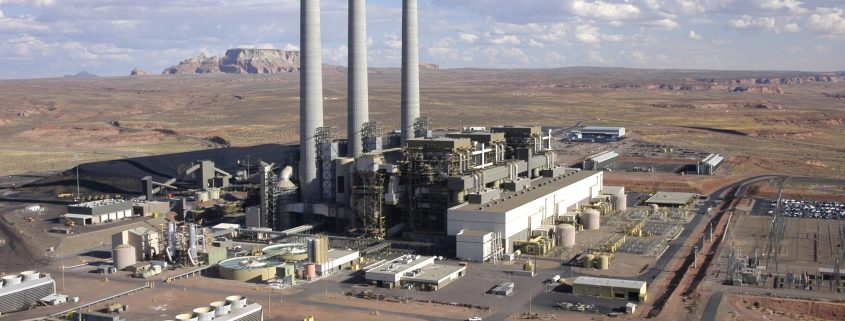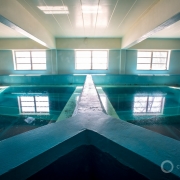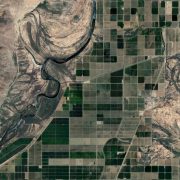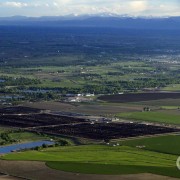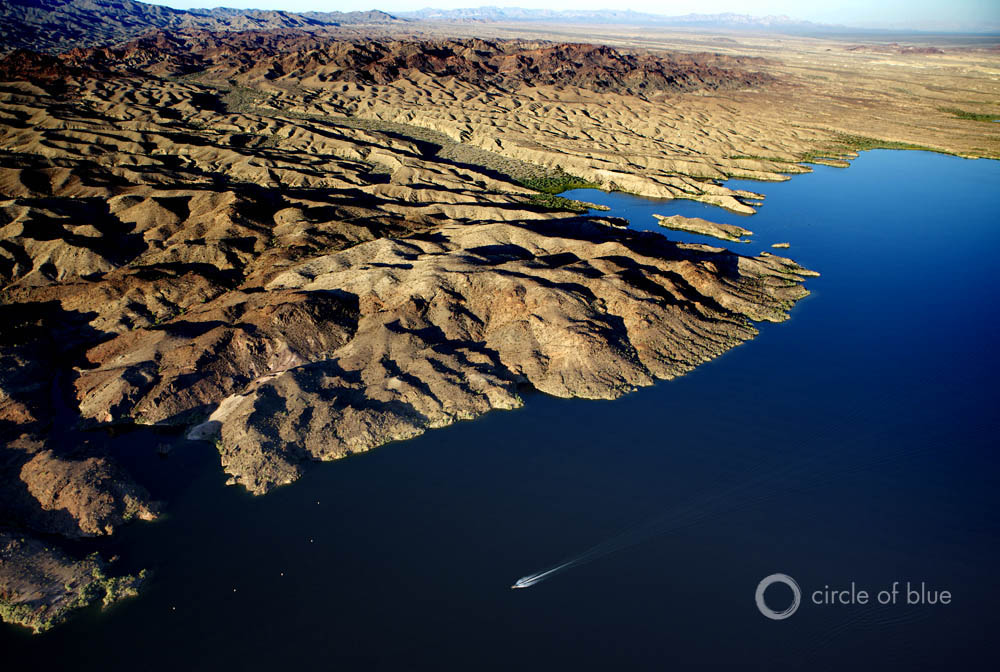Utilities Move to Break Arizona’s Coal-Water Link
The proposed halt to operations in 2019 at the West’s largest coal-fired power plant could attract White House attention.
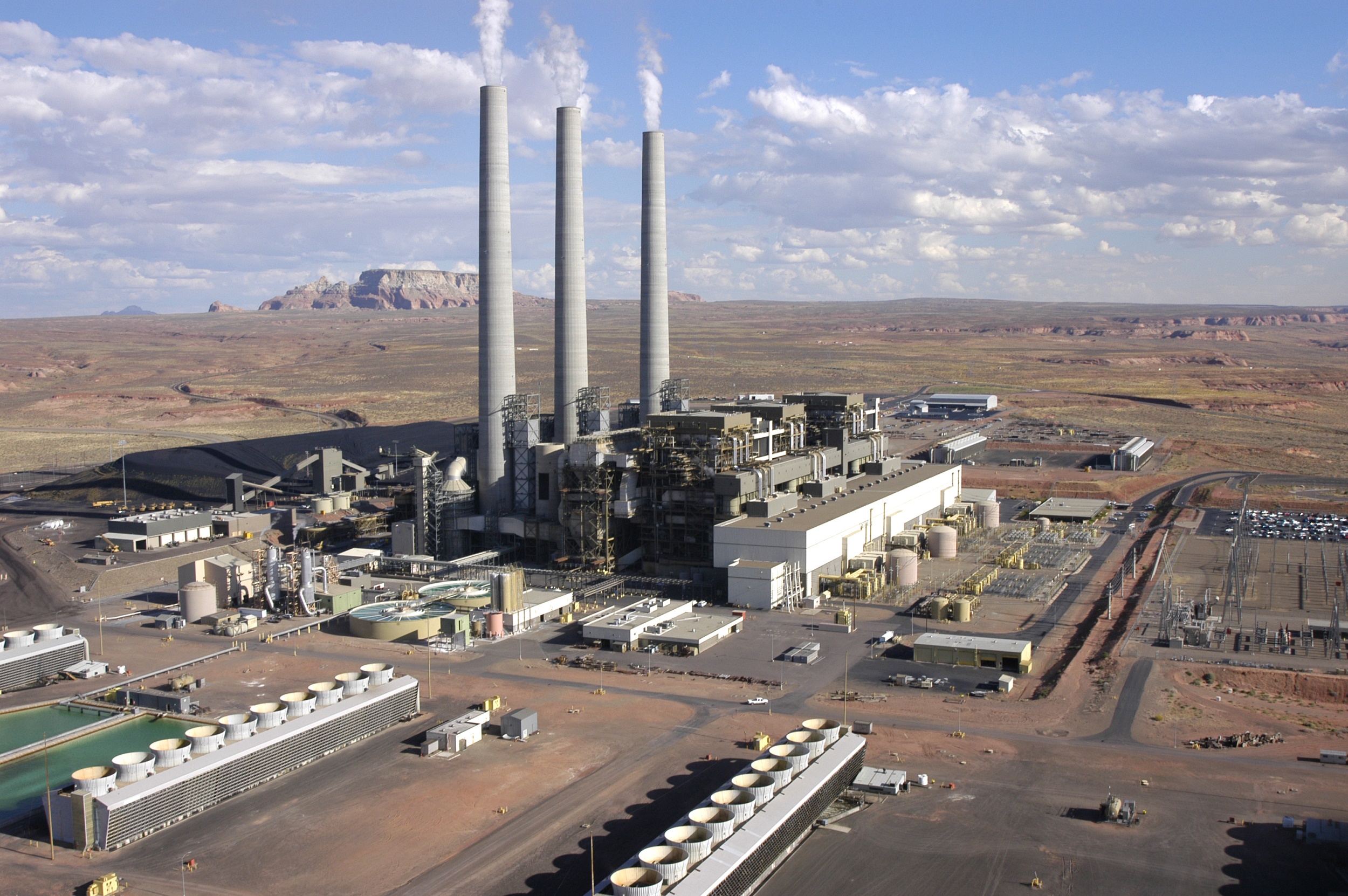
Four utility owners of Navajo Generating Station indicated on February 13 that they would operate the plant after December 2019. Photo courtesy of Salt River Project
By Brett Walton, Circle of Blue
Since 1976 the 2,250-megawatt coal-fired Navajo Generating Station, with its three towering stacks belching thick plumes of steam, has commanded the summit of a high bluff close to the Colorado River in northeastern Arizona. The icon of western electric power has served for more than four decades as a vivid embodiment of American engineering ambition. The plant challenged the desert by joining water, fossil fuel, and pumping technology in a powerful union that slaked the thirst of Arizona’s farms and cities, and sustained a prosperous economy.
That happy marriage, which for decades was seen as pragmatic and strong in the American West, is now breaking apart. Water availability in the Colorado River is declining and demand outpaces supply. America, like China and India, has heeded concerns about climate change and is pivoting away from coal as a fuel source as cheaper and cleaner alternatives emerge. Meanwhile, the cost of maintaining and operating Navajo Generating Station, now more than 40 years old and the seventh-largest source of power plant carbon emissions in the United States, is climbing.
Given these new factors the plant’s four utility owners are seriously thinking of walking away. In a joint statement on February 13 the Salt River Project, NV Energy, Tucson Electric Power, and Arizona Public Service said that they plan to operate through the end of the facility’s December 2019 lease but no later. The closure plan is attracting strong opposition from miners that supply the plant’s coal, and could generate a new struggle over rights to the billions of gallons of Colorado River water needed each year to operate and cool the generating station. The contest could become heated enough to attract intervention by the White House.
Navajo Generating Station draws water from Lake Powell, a Colorado River reservoir, to cool its three generating units. A portion of its electricity pushes Colorado River water 3,000 feet uphill, through the canals and pump stations of the Central Arizona Project, to Phoenix and Tucson. The imported water, supplied by the largest power consumer in Arizona, reduces pressure on groundwater supplies in central Arizona.
The agreement announced last week was prompted by market shifts, and revealed divergent visions of the region’s energy future. The four utility owners cited cheaper natural gas as justification for shutting down Navajo’s coal-burning units.
The federal government, which owns a quarter of the plant’s output, and the Navajo Nation leadership, however, have a different view. They argue it’s all about jobs. Dan DuBray, a Bureau of Reclamation spokesman, told Circle of Blue that it is the government’s trust responsibility to aid tribal economies. Navajo Generating Station and Kayenta mine, which supplies coal to the power plant, together employ roughly 845 Native Americans and contribute tens of millions to the tribes in tax payments and royalties, according to federal documents. The Obama administration published a federal environmental review last September that recommends extending the plant’s lease through 2044.
Navajo Nation leaders also object to closure and want the lease extended. They asked Donald Trump to uphold his campaign promise to protect coal jobs by saving the plant.
The Bureau of Reclamation is convening a stakeholder meeting on March 1 in Washington, D.C. to discuss options for keeping the plant operating beyond 2019.
Cheaper Power A Better Deal for Central Arizona Water Customers
The fate of the Navajo plant is not the only big infrastructure water-energy project at stake in Arizona. Modest natural gas prices also have brought about a swift reversal of fortune for the Central Arizona Project.
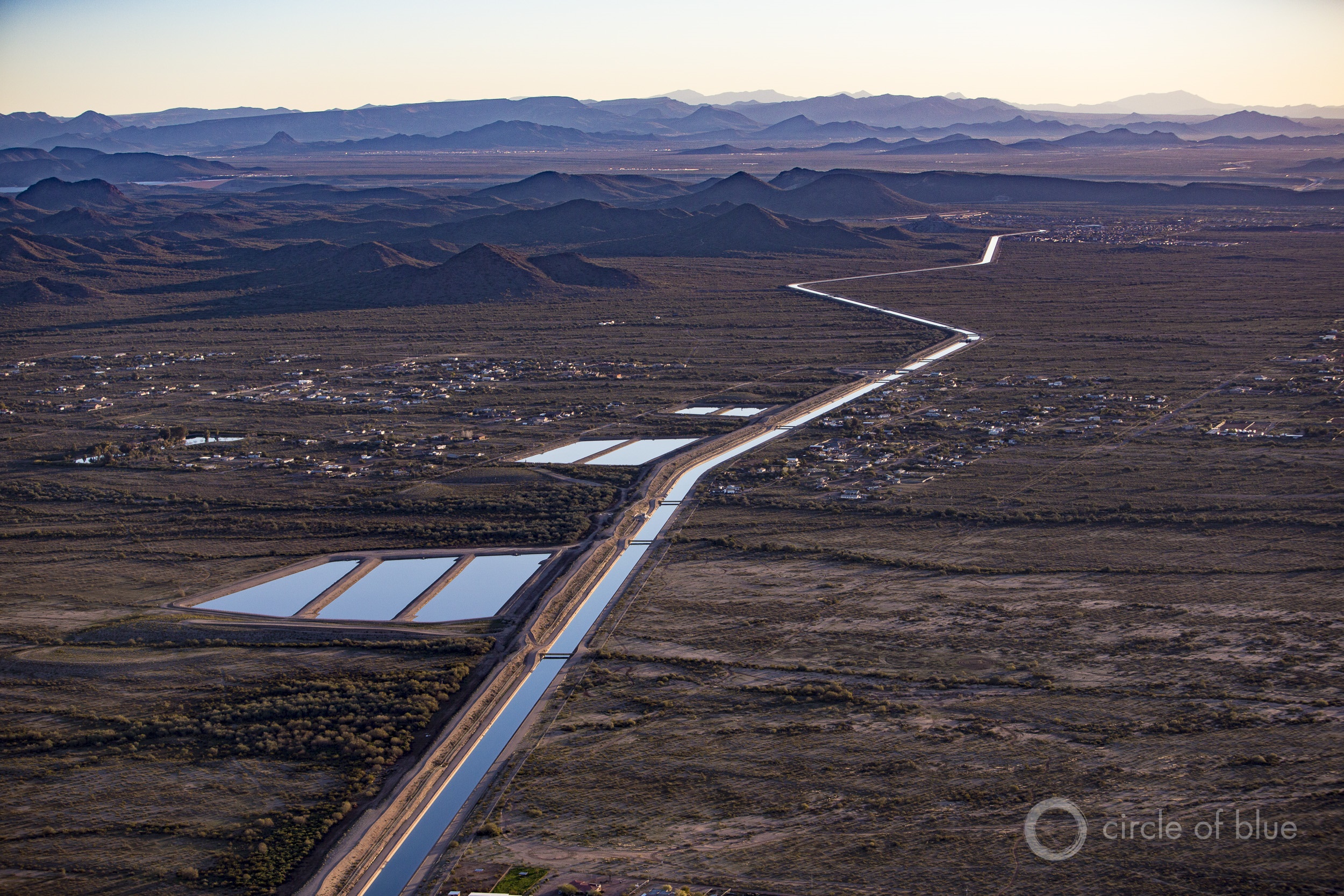
The Central Arizona Project canal snakes 336 miles across the desert to deliver water to three counties in the heart of the state. Photo © J. Carl Ganter / Circle of Blue
In 2010, CAP officials reckoned that closing the Navajo plant would have increased the cost of electricity to pump water by 50 to 300 percent and they would lose $US 50 million per year in the sale of surplus power. Surplus power, which is the difference between the federal government’s allocation and what CAP requires, is sold to pay down Arizona’s share of the CAP construction cost. The remaining balance is roughly $US 1.2 billion.
The U.S. natural gas boom, which ramped up just before CAP made its 2010 forecast, flipped the calculations. In a February 16 presentation to the agency’s board, CAP officials estimated that they would have saved $US 38.5 million in energy costs in 2016 by buying power on the market instead of from the Navajo station. Even though surplus power sales would have declined by $US 12 million in this scenario, CAP still would have come out ahead last year from switching energy sources.
The net savings of $US 26.5 million would have been expressed in lower water bills for tribes, farmers, and cities. Farmers buying water from CAP, for instance, pay only the cost of pumping water. In 2016 that rate, including rebates, was $US 57 per acre-foot using Navajo station power. With power purchased on the market, however, CAP figures the charge would have been $US 49 per acre-foot, a savings of 14 percent. One acre-foot is 326,000 gallons.
“Everything is evaluated in light of conditions we find ourselves in now,” Tom McCann, deputy general manager of CAP, told Circle of Blue. “Today, NGS closing would be a good deal for CAP. If you asked that question four or five years ago, the answer would have been, ‘No.’ There was one answer then and a different answer now because the market fundamentals have changed.”
There is no guarantee that natural gas prices remain low, but McCann does not expect the market to change much for a number of years.
McCann said that if the Navajo station closes, CAP is responsible for finding a replacement energy source. The agency is not likely to put all its eggs in one basket as it does now. “We don’t want to be in the same situation as the last decades where a vast majority of our power came from one source,” he said. In a portfolio approach, no single source would account for more than 15 to 20 percent of CAP’s total energy supply. Today, roughly 92 percent of CAP’s energy comes from Navajo.
What Happens to Navajo’s Colorado River Water?
Another huge factor is water. The Navajo Generating Station has rights to consume 34,100 acre-feet of Colorado River water per year. The water is withdrawn from Lake Powell and not returned to the river system. The plant, however, does not use the entire allocation. Over the last 15 years, annual use has ranged from 26,000 acre-feet to 29,000 acre-feet.
The water rights are owned by the state of Arizona and could be reallocated if the plant were to close. The existing rights are part of Arizona’s 50,000 acre-foot Upper Colorado River Basin allocation, which restricts the water used to the northeastern corner of the state, Leslie Meyers, manager of Reclamation’s Phoenix office, told Circle of Blue. In practice, that means only on the Navajo Nation.
In 1968, as part of the deal to build Navajo Generating Station on tribal land, the Navajo Nation Council promised not to make any claim to the power station’s 34,100 acre-foot allocation for 50 years or for as long as the plant was in operation. If those terms expired, the Council’s resolution directs the Secretary of the Interior to return the allocation “to the Navajo Tribe for their exclusive use and benefit.” That resolution is “still in effect” and incorporated into the plant’s lease, according to Meghan Cox, a Navajo Nation spokeswoman.
Others with a stake in the water rights say it is too early to determine how the water will be used if the plant shuts down.
Douglas MacEachern, Arizona Department of Water Resources spokesman, told Circle of Blue that “until more facts unfold, it is premature to anticipate what might occur with the NGS water rights.” The department would not comment on the Navajo Council’s 1968 resolution.
DuBray, the Reclamation spokesman, said that what happens to the water “is one of myriad questions that need to be addressed.”
Salt River Project, the operator of Navajo Generating Station and current holder of the water rights, is willing to work with Arizona and Navajo officials on a plan for the water if the plant is shut down, Scott Harelson, SRP spokesman, told Circle of Blue.
Even the Navajo Nation is still deciding its course of action. Navajo President Russell Begaye established a task force in October 2016 to review options for the water that the power station currently uses.
If no other use is found, the water could remain in the river. States in the upper and lower basins of the Colorado River have in recent years attempted to boost declining water levels in Lake Mead and Lake Powell. The annual water right assigned to Navajo Generating Station is roughly equal to the amount of water that the three lower basin states — Arizona, California, and Nevada — stored in Lake Mead in 2016 through a pilot conservation program. The cost of that program: $US 5.8 million for 35,369 acre-feet.
Federal officials, however, hope to avoid a plant closure and a reallocation scenario. On March 1, the Department of the Interior, Reclamation’s parent agency, will host a stakeholder meeting in Washington, D.C. to discuss the future of Navajo Generating Station. Invited parties include the four utility owners of the facility plus the Navajo and Hopi tribes, and Central Arizona Project officials. Also invited to the meeting are tribes that get water from the Central Arizona Project and Peabody Energy, which operates the coal mine that supplies Navajo Generating Station.
“Before we discuss where we’re going with closing the plant, we want to look at paths for operating post-2019,” DuBray, the Reclamation spokesman, told Circle of Blue.
DuBray would not comment on potential paths, saying that the March 1 meeting is designed to begin a discussion. Other observers, however, offered suggestions.
Martin Pasqualetti, an Arizona State University professor and co-director of the Energy Policy Information Council, pointed to a number of options. The Trump administration could deem the Navajo plant in the national interest. Or the Navajo Nation could purchase part of the power plant outright.
“Certainly there are a lot of moving pieces on this issue, but they primarily revolve around making up for lost jobs and helping the tribes with some economic development,” Pasqualetti wrote to Circle of Blue in an email.
Brett writes about agriculture, energy, infrastructure, and the politics and economics of water in the United States. He also writes the Federal Water Tap, Circle of Blue’s weekly digest of U.S. government water news. He is the winner of two Society of Environmental Journalists reporting awards, one of the top honors in American environmental journalism: first place for explanatory reporting for a series on septic system pollution in the United States(2016) and third place for beat reporting in a small market (2014). He received the Sierra Club’s Distinguished Service Award in 2018. Brett lives in Seattle, where he hikes the mountains and bakes pies. Contact Brett Walton

